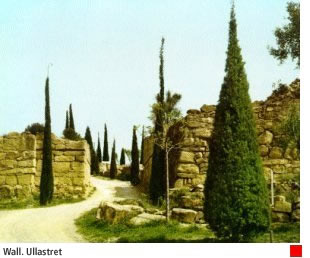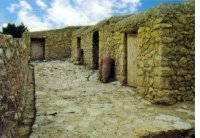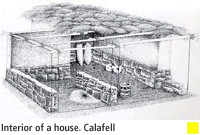
The urban development in Iberian civilization
 The Iberian villages were usually on high ground, overlooking the fields of the surrounding area and land or sea routes.
The Iberian villages were usually on high ground, overlooking the fields of the surrounding area and land or sea routes.
The population was also dispersed, in farm houses, agricultural exploitation in areas privileged for their wealth ease of communication. This could have been the case of Pontos, the commercial centre for the redistribution of cereals in the Alt Emporda, with the Greeks from Empuries.
 Nearly all the villages were fortified with walls and towers which were circular in case of the oldest. Some of them were very impressive, such as the one in Ullastret (Girona), built using Greek building techniques, due to the influence of the Greeks in Empuries, the centre for redistribution of products in the Lower Emporda.
Nearly all the villages were fortified with walls and towers which were circular in case of the oldest. Some of them were very impressive, such as the one in Ullastret (Girona), built using Greek building techniques, due to the influence of the Greeks in Empuries, the centre for redistribution of products in the Lower Emporda.
The walls of Catalan villages were built directly from the ground up, with no foundations, the lowest rows being made of very large stones. In the first villages, the ornamentation of the walls was smooth, and they had no towers, reminiscent of the defences built by the Indo-European in their villages with the back walls of their houses. In front of the main gates of the village they built some bastions or opened graves to protect the weakest point in the defences. Sometimes the entrance was converted into an L-shaped passageway to make the entrance of enemies more difficult.
 There may have been several doors, as well as small postern gates if the length of the defences demanded it. From the IV Century BCE. on, the ground plans of the villages along the coast, influenced by the Greeks, tended to be squares formed by parallel streets, crossing perpendicularly. The houses, with one or two rooms, had walls of clay, built on a base of stone and sometimes dug into the rock to avoid having to build foundations.
There may have been several doors, as well as small postern gates if the length of the defences demanded it. From the IV Century BCE. on, the ground plans of the villages along the coast, influenced by the Greeks, tended to be squares formed by parallel streets, crossing perpendicularly. The houses, with one or two rooms, had walls of clay, built on a base of stone and sometimes dug into the rock to avoid having to build foundations.
 The roof, with one or two sloping sides, was made of branches and clay, and had a hole to let the fumes of the fireplace out, the fire being in the middle, for cooking and heating. In many villages there are squares or yards for communal use, where there could have been bread ovens or ceramic kilns, herds of animals, storerooms for grain, water cisterns or waterholes for rubbish.
The roof, with one or two sloping sides, was made of branches and clay, and had a hole to let the fumes of the fireplace out, the fire being in the middle, for cooking and heating. In many villages there are squares or yards for communal use, where there could have been bread ovens or ceramic kilns, herds of animals, storerooms for grain, water cisterns or waterholes for rubbish.
The most important villages might have had public buildings such as temples, which suggests the existence of a hierarchical organisation, where the smallest villages depended on the more important ones in many areas, such as providing channels for excess goods and their exchange for manufactured foreign products.